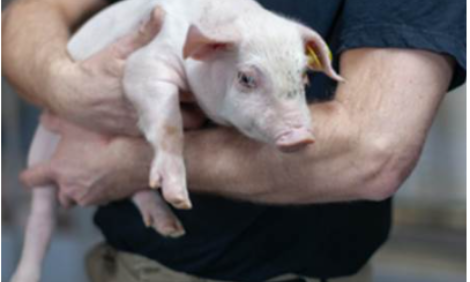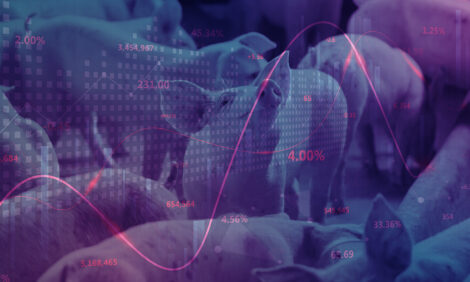



Keys to Finisher Stocking Density Uncovered at Kansas Swine Day
Two papers presented at last year's Kansas State University Swine Day Report help to clarify the best stocking density for finishing pigs and whether mixing should be carried out, writes Douglas Richards, Ontario agriculture ministry's Swine-Grower Finisher Specialist in the latest Pork News and Views from OMAFRA.The Swine Day 2010 Report of Progress 1038 contains updates and summaries of applied and basic research conducted at Kansas State University.
Producers with finishing operations may wonder about the impact of mixing market weight pigs during times of shipping to better utilise pen space, or regroup different pens of market weight animals to help pen flow in continuous operations. The question has also been asked many times on what is the best stocking density (square feet per pig) for market hogs.
Below are summaries of two research studies looking at those questions. For the full study results, please go to the link below.
Effects of Mixing Late-Finishing Pigs Just Before Marketing on Growth Performance
In their paper at the Swine Day 2010, M.L. Potter et al. explain that variation in pig weights within barns managed on an all-in/all-out basis has led to adoption of strategies to minimise profit loss due to marketing of lightweight pigs. Mixing or combining pens of pigs around the time of marketing has become a common practice to assist with pig flow. This allows space to be emptied for washing and refilling while allowing remaining pigs to be held for additional weight gain. Past research has shown that mixing of grow-finish pigs negatively affects average daily gain (ADG) immediately after mixing. Some reports also indicate that, with enough time allowed, mixed pigs may experience compensatory gain that mitigates the negative effects of mixing.
The objective of the trial was to determine the effects on pig performance of mixing different numbers of close-to-market-weight pigs from one or two barns prior to marketing.
The 15-day study looked at four different groupings:
- 1. non-mixed pens with 12 barn A pigs (control)
- 2. mixing 6 barn A pigs with 6 barn B pigs within a pen (Mix 1)
- 3. mixing 10 barn A pigs with 10 barn B pigs within a pen (Mix 2)
- 4. mixing 10 barn A pigs with 10 barn A pigs within a pen (Mix 3)
The pigs were all fed the same ration and no pigs were shipped from any pens during the trial. Pens of pigs were weighed and feed disappearance determined on days 0, 8 and 15. From the data, ADG, average daily feed intake (ADFI) and feed to gain ratio (F/G) were calculated.
* "Increasing the number of pigs per pen had a greater effect on performance than mixing pigs" |
The results from day 0 to 8 and day 8 to 15 suggest that the number of pigs per pen had a large impact on performance. Overall, ADFI was lower for the higher stocking-density pens (20 versus 12 pigs per pen). Because of the difference in ADFI, overall ADG was decreased and off-test weight lighter for the Mix 3 treatment (20 pigs per pen) than for the control and Mix 1 (both stocked at 12 pigs per pen). Mix 2 (20 pigs per pen) tended to have lower ADG and weigh less compared with treatments stocked at 12 pigs per pen.
This data indicates that increasing the number of pigs per pen had a greater effect on performance than mixing pigs. Despite early numerical negative effects of mixing, overall, there was no difference in performance for mixed pigs and non-mixed control pigs when stocked at a similar density (12 pigs per pen). Therefore, mixing of pigs prior to market does not appear to affect overall performance as long as pigs are allowed time to adjust to the environment and establish a new social structure.
Effects of Increasing Stocking Density on Finishing Pig Performance
Recommendations for finishing pig stocking density vary from approximately 6.0 to 9.0 ft2 per pig, depending on factors to be optimized, according to M.L. Potter et al. in another paper presented at the same conference. Pig performance is improved with more space per pig, while facility cost per pig, economic return, and overall efficiency are likely to be improved with less space allowed. Other factors, including pig flow and facility availability, also affect practicality of achieving an optimum stocking density.
A report by the National Pork Board indicated that, on average, swine operations stock pens at approximately 7.2 square feet per pig. In the facilities used for this experiment, stocking 25 pigs per pen allowed 7.2 square feet per pig. Understanding the effects of different stocking densities on performance can aid pig flow decision making and help producers maximize income by balancing fixed costs with effects on performance. The objective of this experiment was to determine the effects of different stocking densities (6.4, 6.9, 7.5 or 8.2 square feet per pig) on performance of finisher pigs.
A total of 1,201 finishing pigs (initially 63lb) were used in a 99-day growth trial to evaluate the effects of increasing stocking density on finishing pig growth performance. Pens were stocked with 22, 24, 26 or 28 pigs each, allowing 8.2, 7.5, 6.9 and 6.4 square feet per pig, respectively. Pens of pigs were weighed and feed intake was determined on day 0, 14, 28, 42, 56, 70, 84 and 99 to calculate ADG, ADFI, and F/G. Pigs were fed common diets throughout the trial.
* "Income over feed and facility cost per pig placed was numerically optimised when pens were stocked with 24 pigs each, allowing 7.5 square feet of floor space per pig" |
Overall, as stocking density increased, ADG and ADFI decreased but there were no differences in F/G. These performance differences resulted in off-test (day 99) pig weights decreasing as stocking density increased. This data indicates that in this commercial barn, finisher pig ADG and ADFI improved as the number of pigs in each pen was reduced. However, based on an economic model, income over feed and facility cost per pig placed was numerically optimised when pens were stocked with 24 pigs each, allowing 7.5 square feet of floor space per pig.
Regardless of potential other contributing factors, results of this trial indicate that growth rate and feed intake increased as stocking density per pen decreased. However, based on an economic model of this data, income over feed and facility cost per pig placed was numerically highest when pens were stocked with 24 pigs. Therefore, in this commercial barn, the negative effects on performance from higher stocking and reduction of space per pig could not be overcome by throughput alone. Similarly, numbers and weight of pigs when stocked at 22 pigs per pen were low enough that even the improvements in ADG, compared with pigs from higher stocked pens, could not overcome the increased facility cost per pig placed compared to stocking at higher densities.
Therefore, these results indicate that ADFI and ADG of pigs improved as stocking density was reduced from 28 to 22 pigs. However, income over feed and facility cost appeared to be numerically optimised when pens were stocked at 24 pigs per pen, allowing 7.5 square feet of floor space per pig.
Further Reading
| - | You can view the Kansas Swine Day 2010 report by clicking here. |
February 2011








